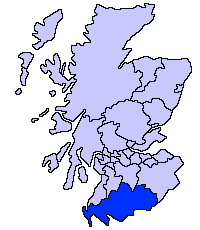| Name | Location | Description | Ref No | Image |
|---|
| Little Hartfell Stone Circle | Hutton And Corrie | Remains of Neolithic/Bronze Age stone circle | SM636 |  |
| Twelve Apostles Stone Circle | Holywood | Prehistoric stone circle | SM641 |  |
| Burnswark Hill | Hoddom | Traces of fort and Roman camps | SM667 |  |
| Auchen Castle | Moffat | Remains of Auchen Castle | SM683 |  |
| Crichton Peel and Sanquhar Castle | Sanquhar | Ruined castle | SM687 |  |
| Mote of Annan | Annan | Traces of 12th-century motte and bailey castle | SM702 | |
| Repentance Tower | Hoddom | Remains of an intact, roofed 17th-century watchtower | SM706 |  |
| Tibbers Castle | Penpont | Remains of motte-and-bailey castle | SM711 |  |
| Dumfries Old Bridge (Devorgilla Bridge) | Dumfries | Rebuilt 15th century bridge | SM715 |  |
| Cairnderry chambered cairn | Minnigaff | Remains of cairn | SM1007 |  |
| Glenquicken stone circle (Billy Diamond's Bridge stone circle) | Kirkmabreck | Remains of prehistoric stone circle | SM1023 |  |
| High Banks Farm, cup and ring marks | Kirkcudbright | Cup and ring marked rocks | SM1028 |  |
| Trusty's Hill | Anwoth | Fort and symbol stones | SM1100 |  |
| Buittle Old Kirk | Buittle | Ruined church | SM1108 |  |
| Buittle Castle | Buittle | Remains of medieval Balliol castle | SM1115 |  |
| Castle Haven dun | Borgue | Restored dun | SM1116 |  |
| Earlstoun Castle | St John's Town of Dalry | Tower house | SM1118 |  |
| Plunton Castle | Borgue | 16th-century tower house | SM1129 |  |
| Doon Castle Broch | Stoneykirk, Rhins of Galloway | Remains of an iron-age broch (fortified roundhouse) | SM1970 |  |
| Portpatrick old parish kirk | Portpatrick | Roofless church with round tower | SM2008 |  |
| Dunskey Castle | Portpatrick | Ruined 16th-century L-plan tower house | SM2017 |  |
| Galdenoch Castle | Leswalt | Ruined tower-house | SM2018 |  |
| Old Tower of Sorbie | Sorbie | Ruined 16th-century tower-house | SM2024 |  |
| Kirkcudbright Castle (MacLellan's Castle) | Kirkcudbright | Ruined 16th century castle | SM2459 |  |
| Cruggleton Castle | Sorbie | Remains of medieval castle | SM3811 |  |
| Edingham Castle | Dalbeattie | Ruined tower-house | SM6412 |  |
| Soulseat Abbey | Inch, Wigtownshire | Mound and gravestones marking site of abbey on promontary in Soulseat Loch | SM7426 | |
| Kenmure Castle | Kells | Ruined 16th- and 17th-century courtyard house of the Gordons of Lochinvar | SM7743 |  |
| Girthon Old Kirk | Girthon | Roofless 17th-century church | SM7868 |  |
| Cumstoun Castle | Twynholm | Remains of 16th-century castle | SM8263 |  |
| Dalton Old Parish Church | Dalton | Remains of Dalton old parish church | SM8676 |  |
| Auchenskeock Castle | Colvend and Southwick, near Dalbeattie | 17th-century tower house | SM10434 |  |
| Whithorn Priory | Whithorn | Remains of a large early historic monastic settlement | SM12992 |  |
| Barsalloch Fort | Mochrum | Traces of prehistoric fort | SM90030 |  |
| Caerlaverock Castles (Old and New) | Caerlaverock | Ruined castles | SM90046 |  |
| Cairn Holy I | Kirkmabreck | Chambered cairn | SM90049 |  |
| Cairn Holy II | Kirkmabreck | Chambered cairn | SM90050 |  |
| Cardoness Castle | Anwoth | Ruined tower house | SM90058 |  |
| Carsluith Castle | Kirkmabreck | Ruined L-plan tower-house | SM90062 |  |
| Drumcoltran Tower | Kirkgunzeon | 16th-century tower-house | SM90100 |  |
| Drumtroddan cup markings | Mochrum | Cup and ring-marked rocks | SM90101 |  |
| Drumtroddan standing stones | Mochrum | 3 standing stones | SM90102 |  |
| Dundrennan Abbey | Dundrennan | Ruined 12th-century abbey | SM90114 |  |
| Glenluce Abbey | Old Luce | Ruined 12th century Cistercian abbey | SM90153 |  |
| Kirkmadrine Church | Stoneykirk | Old parish church of Kirkmadrine and early gravestones | SM90192 |  |
| Lincluden Collegiate Church | Terregles, near Dumfries | Remains of a Collegiate Church | SM90200 |  |
| Lochmaben Castle | Lochmaben | Ruined 13th/14th-century peel and castle | SM90205 |  |
| Orchardton Tower | Buittle | Remains of late 15th-century circular tower house | SM90233 |  |
| Rispain Camp | Whithorn | Earthworks of late Iron Age fort | SM90248 |  |
| Sweetheart Abbey | New Abbey | Remains of 13th-century Cistercian Abbey | SM90293 |  |
| Threave Castle | Balmaghie | Remains of 14th-century tower-house | SM90301 |  |
| Torhouse Stone Circle | Wigtown | Prehistoric stone circle | SM90304 |  |
| Wren's Egg | Glasserton, Wigtownshire | Standing stones | SM90316 |  |
















































